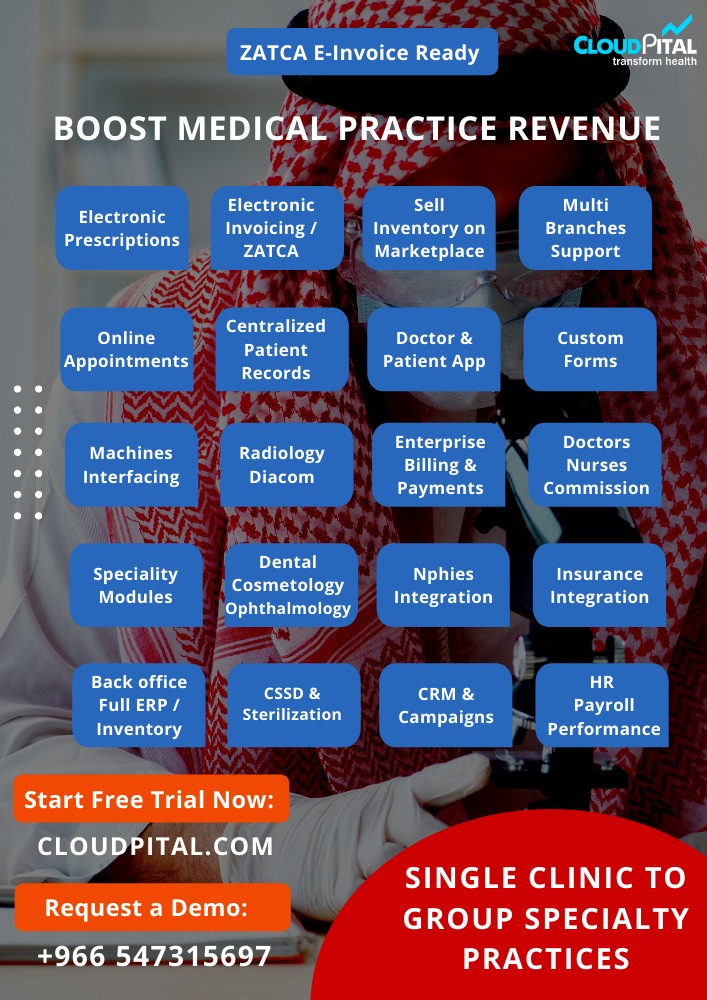Cloudpital # 1 is a top EMR System In the ever-evolving landscape of healthcare, technology plays a pivotal role in enhancing patient care and improving efficiency. Electronic Medical Record (EMR) systems have revolutionized the way healthcare providers manage patient information. One of the most critical aspects of healthcare is the handling of imaging and diagnostic reports, and EMR systems have become instrumental in streamlining this process.
Click to Start WhatsApp Chatbot with Sales
Mobile: +966547315697
Email: sales@cloudpital.com
Cloudpital #1 EMR System

How do EMR System handle imaging and diagnostic reports?
In this blog post, we will explore how EMR systems handle imaging and diagnostic reports, offering a glimpse into the future of healthcare management.
The Role of Imaging and Diagnostic Reports
Before delving into the specifics of how EMR System manage these reports, it’s essential to understand their significance in healthcare. Imaging and diagnostic reports are the cornerstones of modern medicine. They encompass a wide range of data, including X-rays, MRIs, CT scans, pathology reports, and more. These reports provide invaluable insights into a patient’s condition, aiding in diagnosis, treatment planning, and ongoing care.
In the past, these reports were primarily paper-based, leading to inefficiencies, delays, and potential errors. EMR systems have transformed this landscape by digitizing and streamlining the management of these vital documents.
Digitization of Reports
The first step in handling imaging and diagnostic reports with EMR systems is digitization. When a patient undergoes a diagnostic test or imaging procedure, the results are typically generated in digital format. EMR systems are equipped to receive, store, and manage these digital files seamlessly.
Upon receipt, these digital reports are securely stored within the EMR database, making them readily accessible to authorized healthcare professionals. This eliminates the need for physical storage space, reduces the risk of document loss, and ensures that reports are available when needed.

How do EMR System handle imaging and diagnostic reports?
Integration with PACS
Picture Archiving and Communication Systems (PACS) play a crucial role in the management of medical images. EMR Software is designed to integrate seamlessly with PACS, enabling healthcare providers to access diagnostic images directly from the patient’s electronic record.
This integration ensures that healthcare professionals have immediate access to both the diagnostic report and the accompanying images. It streamlines the diagnostic process, allowing for faster and more accurate decision-making. Whether it’s a radiologist interpreting an MRI or a surgeon planning a procedure based on a CT scan, EMR systems ensure that the necessary information is readily available.
Accessibility and Collaboration
One of the most significant advantages of EMR systems is their ability to facilitate collaboration among healthcare providers. Multiple specialists may need to review and discuss the findings when handling imaging and diagnostic reports. EMR systems enable real-time access to these reports, regardless of the provider’s location.
For example, a primary care physician can easily share a patient’s diagnostic report with a specialist, such as a cardiologist or an oncologist. This collaborative approach enhances the quality of care and ensures that all relevant parties are informed and engaged in the patient’s treatment plan.
Data Analytics and Decision Support
In addition to storage and accessibility, the EMR System offers advanced capabilities in data analytics and decision support. These systems can analyze large datasets, including imaging and diagnostic reports, to identify trends, correlations, and potential treatment options.
For example, machine learning algorithms can assist healthcare providers in diagnosing conditions by analyzing patterns in medical images. Decision support tools integrated into EMR systems can suggest evidence-based treatment options, helping providers make informed decisions quickly.
Future Possibilities
As technology continues to advance, the capabilities of EMR systems for handling imaging and diagnostic reports are likely to expand further. The integration of artificial intelligence (AI) and machine learning will enhance the accuracy and speed of diagnoses. Moreover, the interoperability of EMR systems with other healthcare technologies, such as telemedicine platforms, will enable remote consultations and more efficient healthcare delivery.
EMR systems have transformed the way healthcare providers handle imaging and diagnostic reports. By digitizing, integrating, and securing these critical documents, clinic Software has improved patient care, collaboration among healthcare professionals, and the overall efficiency of healthcare operations. As technology continues to advance, EMR systems will continue to play a pivotal role in shaping the future of healthcare management, ultimately benefiting patients and healthcare providers alike.
Click to Start WhatsApp Chatbot with Sales
Mobile: +966547315697
Email: sales@cloudpital.com
EMR System
EMR System
EMR System
EMR System
How do EMR System handle imaging and diagnostic reports? similar software solutions prices were updated on 2024-05-02T10:33:34+00:00 in Saudi Arabia in Mecca, Medina, Riyadh, Khamis Mushait, Yanbu, Jeddah, Dammam, Unaizah, Uqair, Ha’il, Ta if, Al Bahah, Dhahran, King Abdullah Economic City, Najran, Diriyah, Qatif, Khafji, Jubail, Abqaiq, List of Cities and Towns in Saudi Arabia, Ras Tanura, Turubah, Jazan Economic City, Knowledge Economic City, Medina, Khobar, Abha, Tabuk, Saudi Arabia, similar software solutions prices were updated on 2024-05-02T10:33:34+00:00 We also provide in Saudi Arabia services solutions company in Hafar Al-Batin, Udhailiyah, Al-Awamiyah, Hofuf, Hautat Sudair, Buraidah, Tayma, Duba, ‘uyayna, Saihat, Al-Kharj, Al-ula, Jizan, Rumailah, Ar Rass, Arar, Shaybah, Al Majma’ah, Rabigh, Dhurma, Haradh, List of Saudi Cities by Gdp Per Capita, Badr, Sudair Industrial City, Baljurashi, Shaqraa, Al-Khutt, Habala, Ad Dawadimi, Dawadmi, Layla, similar software solutions prices were updated on 2024-05-02T10:33:34+00:00 Price is SAR 100 and this was updated on updated on 2024-05-02T10:33:34+00:00 similar How do EMR System handle imaging and diagnostic reports? software solutions prices were updated on 2024-05-02T10:33:34+00:00 in Saudi Arabia in Haql, Afif, Al-Abwa, Farasan, Al-Jaroudiya, Thadig, Al-Thuqbah, Al Wajh, Almardmah, Al-Zilfi, Muzahmiyya, Prince Abdul Aziz Bin Mousaed Economic City, Tharmada’a, Skaka, Um Al-Sahek, Sharurah, Tanomah, Bisha, Dahaban, Al Qunfudhah, Qurayyat, Saudi Arabia, Ha’ir, as Sulayyil, Al Lith, Turaif, Al-Gway’iyyah, Samtah, Wadi Ad-Dawasir, Az Zaimah, Safwa City, Jalajil, Harmah, Mastoorah, Hotat Bani Tamim, Jabal Umm Al Ru’us, Rafha, Qaisumah, Al-Ghat, Hajrah, Al-Hareeq. Excerpt: Jeddah (also spelled Jiddah, Jidda, or Jedda; Arabic: Jidda) is a Saudi Arabian city located on the coast of the Red Sea and is the major urban center of western Saudi Arabia similar software solutions prices were updated on 2024-05-02T10:33:34+00:00 Price is SAR 100 and this was updated on updated on 2024-05-02T10:33:34+00:00
02-10-2023



